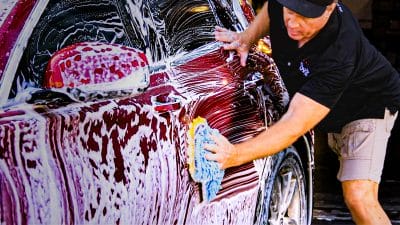Last Updated January 3, 2024
What is orange peel? Recently, for our weekly live detailing class series, Chief Education Officer Mike Phillips did a solo explainer on the topic of orange peel — what it is, why it happens, how to remove it, and why you probably don’t want to if you’re detailing with an OEM (factory) paint system. There’s a lot of great information, so make sure you’re taking notes!
If you’re not familiar, orange peel is a type of texture seen on automotive paint that resembles the skin of an orange. It’s a natural result of the factory painting process that occurs for a variety of reasons that are difficult to explain in short. It can only be removed through paint sanding, which is rarely done in OEM factories and is reserved for only the highest-end vehicles.
Typically you’ll only see detailers and body shop technicians removing orange peel through sanding when there is a thick layer of clear coat on the paint. This is because sanding to remove orange peel is an extremely abrasive process that literally removes the clear coat in order to level out the texture.
To save the big automakers money, OEM cars have the least amount of clear coat possible while still protecting the underlying paint. If you were to sand that small amount of clear coat to remove the orange peel, there’s a good chance you could burn through the clear coat entirely.
For that reason, most people trained in orange peel removal will only do so on thick, aftermarket clear coat. It’s very common on custom cars heading to high-end car shows — not so much for your daily driver SUV.
Check out the livestream recording below to get an even clearer picture of what orange peel is and how to remove it!





Questions? Comments?
Email Us